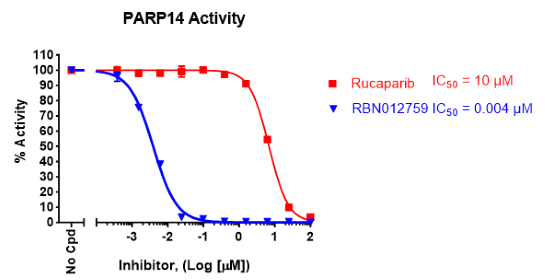PARP14 Chemiluminescent Assay Kit
The PARP14 Chemiluminescent Assay Kit is designed to measure the activity of PARP14 (poly-(ADP-ribose) polymerase 14) for screening and profiling applications. The PARP14 assay kit comes in a convenient 96-well format, with enough recombinant purified PARP14 enzyme (amino acids 1470-1801), reaction substrates, and PARP assay buffer for 100 enzyme reactions.

Figure 1. PARP14 Chemiluminescent Assay Kit schematic.
Histone proteins are coated on a 96-well plate. Next, a biotinylated NAD+ mix (termed PARP Substrate Mixture) is incubated with the PARP14 enzyme in an optimized assay buffer. The plate is then treated with streptavidin-HRP followed by addition of the ELISA ECL substrate to produce chemiluminescence that can be measured using a chemiluminescence reader. The chemiluminescence signal is proportional to the PARP14 activity.
Need us to run inhibitor screens or profile your compounds against PARP14? Check out our PARP/PARPTrap™ Screening Services or DNA Replication and Repair Screening Services.
- 1x PBS (Phosphate Buffer Saline) Buffer
- PBST Buffer (1x PBS, containing 0.05% Tween-20)
- Luminometer or microplate reader capable of reading chemiluminescence
- Adjustable micropipettor and sterile tips
- Rotating or rocker platform
| Catalog # | Name | Amount | Storage |
| 80514 | PARP14, His-GST-Tag* | 5 µg | -80°C |
| 52029 | 5x Histone Mixture | 1 ml | -80°C |
| 78371 | PARP Substrate Mixture 2 | 2 x 250 µl | -80°C |
| 80602 | 10x PARP Assay Buffer | 1 ml | -20°C |
| 79743 | Blocking Buffer 3 | 25 ml | +4°C |
| 0.5 M DTT | 200 µl | -20°C | |
| 80611 | Streptavidin-HRP | 100 µl | +4°C |
| 79670 | ELISA ECL Substrate A (translucent bottle) | 6 ml | Room Temp |
| ELISA ECL Substrate B (brown bottle) | 6 ml | Room Temp | |
| 79837 | 96-well module plate | 1 | Room Temp |
*The concentration of the protein is lot-specific and will be indicated on the tube.
PARP14, also known as poly-(ADP-ribose) polymerase 14 or ARTD8 (ADP-Ribosyltransferase Diphtheria Toxin-Like 8), is part of the PARP family. ADP ribosylation, which is the addition of an ADP-ribose to a protein, is a reversible post-translational modification of proteins mostly involved in the DNA Damage Response (DDR) pathway. Mono-ADP-ribosylation (termed MARylation) is the addition of a unit of ADP-ribose. PARP14 is activated in response to IL-4 stimulation and STAT6 activation. Once active, PARP14 can perform auto-MARylation on HDAC2 (histone deacetylase 2) and HDAC3, dissociate from IL-4 responsive promoters and initiate downstream cascades that can support cancer cells. It can promote protumor macrophage polarization and reduce the inflammatory response to tumors. The use of PARP14 inhibitors, such as RBN012759, can reverse PARP14’s immunosuppressive role, and have potential applications in cancer therapy.
Quin W., et al., 2019 Front Pharmacol 10:172.
Schenkel L., et al., 2021 Cell Chem Biol 28(8): 1158-1168.


